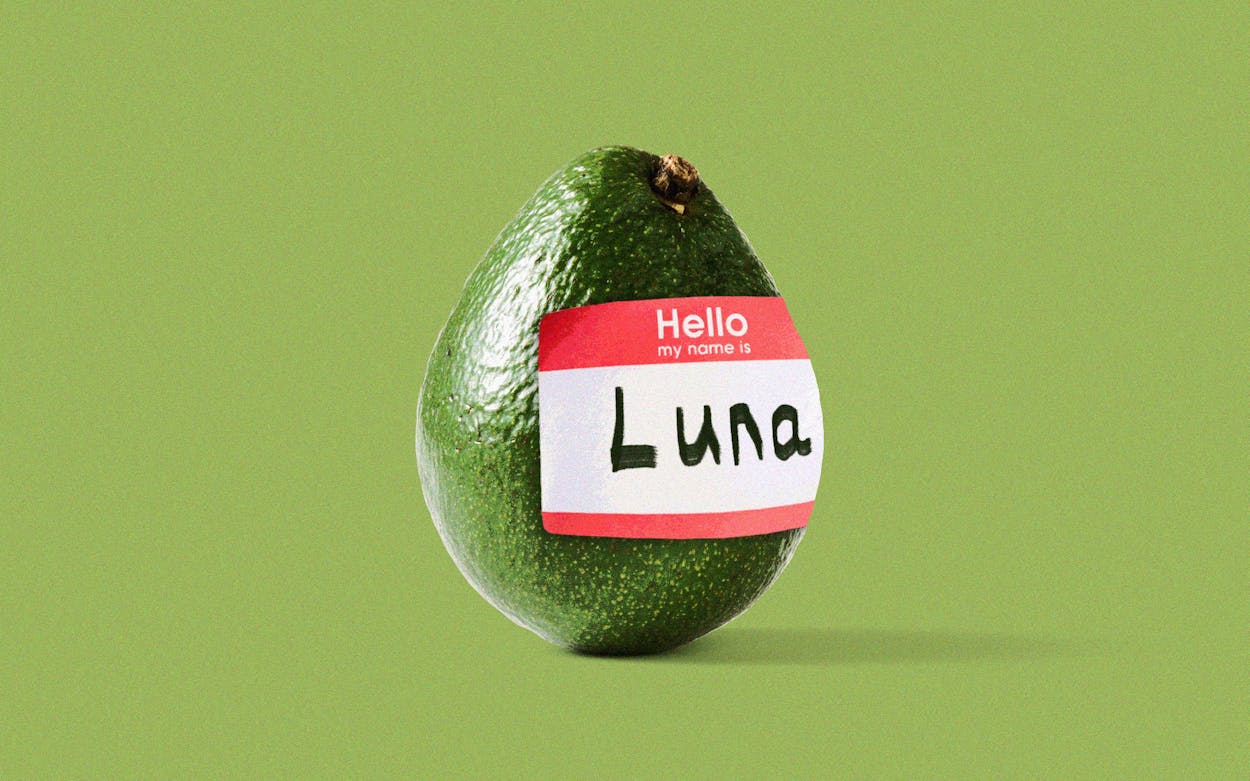Avocados get sunburned, too, you know. It doesn’t show on their pebbly skin the same way it does on ours, but too much sun can scorch yellowish or black patches onto the fruit’s peel. What’s worse is there isn’t a sunscreen on Earth that can prevent their pain.
Enter, Luna—a new variety of avocado less likely to suffer sunburns and more likely to end up mashed into your guacamole, thinly sliced on your toast, or pureed into one of your favorite sauces.
Even though you might be hearing about it for the first time, Luna is considered “the great-granddaughter” of the beloved Hass avocado and is the result of decades of labor. The variety’s co-inventors, horticulturist Mary Lu Arpaia and research associate Eric Focht, began trials in 2012, but the work behind producing Luna really started in the 1950s. Born out of a need to withstand unpredictable and sometimes harsh weather conditions, such as deep freezes, Luna offers hope for a future of “what ifs.” The taste is similar to that of a Hass avocado, nutty and smooth, and in recent consumer panels, some read the flavor as a bit sweet. To Arpaia, the fruit has almost floral characteristics.
As most avocado eaters know, Hass reigns supreme at grocery stores across the nation. According to Avocados From Mexico, 95 percent of all avocados eaten in the U.S. are the Hass variety, which is native to California. The variety comes in an array of sizes and is most notable for its creamy texture—one that lends itself well to a smooth guacamole. However, with strong opportunities for profitability and growing patterns that encourage sustainable production practices, Luna could be the next star of the produce section.
But back to the sunburn. Because the new and improved fruit grows on a more upright, slender tree, it is protected by the tree’s leaf canopy. This provides some coverage from the sun and decreases the need for ladder work, which creates a safer working environment. The tree is also about 50 percent smaller than the size of an average Hass tree. Smaller trees equal more land to plant on, yielding more avocados. Now, that’s my kind of math.
Unfortunately, though, according to Arpaia, Luna might not be available to consumers for another two years or so. Why does this matter to Texans? Everyone from chefs to consumers, and even specific regions of the state, could potentially be impacted by the introduction of Luna.
Diego Galicia and Rico Torres, chef-owners of Mixtli in San Antonio, source their avocados from Mexico, the world’s largest grower and exporter of the fruit. Galicia grew up on a farm in the country and is familiar with the process of growing avocado trees, which can take fifteen to twenty years to bear fruit. When you throw in the cost of labor and stress on the crop brought by higher temperatures due to climate change, the price tag that you see at your local grocery store starts to make sense. During the off-season or low-production months, avocados are transported from other South American countries. Ideally, chefs like Galicia and Torres, who aim to source produce sustainably, hope to avoid the additional costs and fossil fuel emissions brought by importing. “These things matter a lot if we want to continue eating things the way we’re used to. There’re some tweaks that have to be made,” Torres says. “These are small considerations, but I think they eventually have a large footprint of their own.”
More variety in the products available on the market, however, means purveyors and consumers of the healthy-fat food won’t have to sell an arm and a leg to buy it. Though, for Galicia, who wants to honor his roots, sourcing avocados directly from California, as opposed to Mexico, is less than ideal. “There’s a cultural aspect, right? I’m Mexican and avocados are indigenous to Mexico. The Aztecs had a high regard for the fruit. There are [also] economic implications,” he says. “It sounds really complicated. It’s a really good conversation to have.”
California, Spain, and Israel have tested Luna avocado tree growth, and John Jifon, a professor of horticultural sciences at Texas A&M University, is trying to get Texas in on the Luna trials, too. With disease plaguing citrus fruits (the original focus of Jifon’s research) across the South, he has shifted to finding new fruits to help growers diversify their crops. He conducts his research at the Texas A&M AgriLife Research Station in Weslaco and has worked closely with Arpaia to identify avocado-growing opportunities in Texas.
In fact, Luna growth tests are already underway onsite in Weslaco and at an orchard in Los Fresnos. There are upwards of a dozen different avocado varieties planted in the Rio Grande Valley—Gem, Reed, and Lamb Hass, to name a few. Evaluated overall for adaptability, the fruit will need to overcome obstacles like cotton root rot, salinity, and the occasional freeze to thrive in the state. Although it isn’t the first time South Texas has tried to wiggle its way into the avocado industry, Arpaia and Jifon agree: Luna’s distinct characteristics could make the region a permanent home.
“There’s a nickname for it, which is green gold, or black gold, depending on the color,” Jifon laughs. “It’s very popular.”
Although Luna has a few years of testing, prodding, and growing to go, the thought of a fruit so beloved and central to our favorite Mexican and Tex-Mex dishes being able to withstand our progressively inhospitable environment is sweet news indeed.








